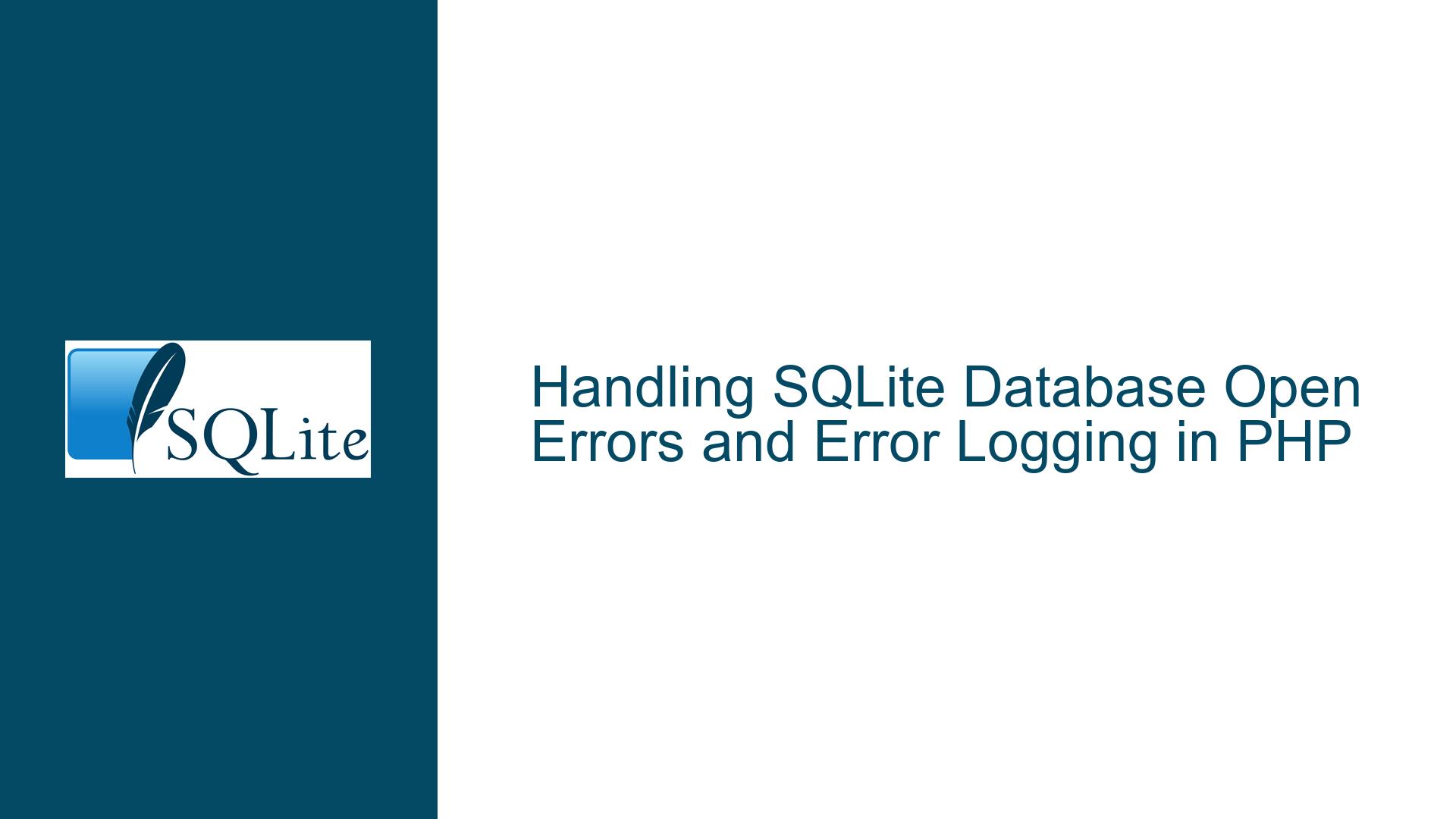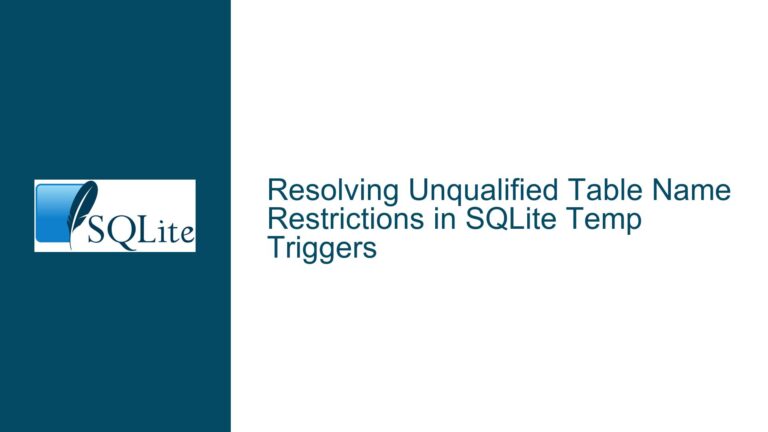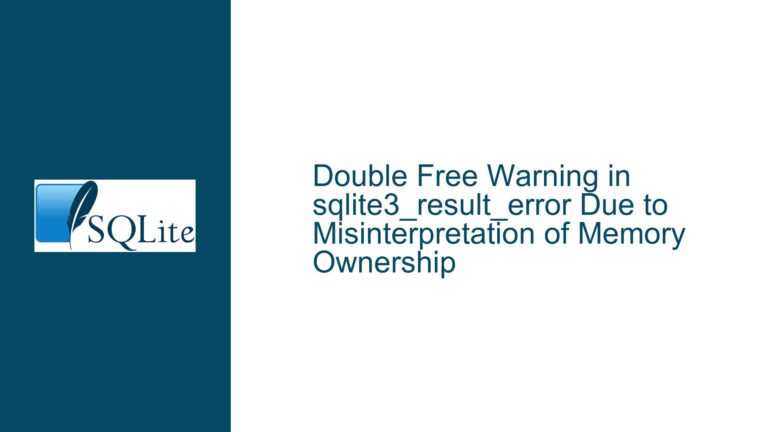Handling SQLite Database Open Errors and Error Logging in PHP
SQLite Database Creation on Open and Error Handling in PHP
When working with SQLite databases in PHP, a common issue arises when attempting to open a database file that does not exist. By default, SQLite will create a new database file if the specified file does not exist. This behavior can be problematic in scenarios where the creation of a new database is not desired, and instead, an error should be returned to the user. Additionally, proper error handling and logging are essential to ensure that the application can respond appropriately to failures, such as the inability to open a database or execute a query.
The core issue revolves around the default behavior of the SQLite3::open method in PHP, which uses the flags SQLITE3_OPEN_READWRITE | SQLITE3_OPEN_CREATE. This combination of flags ensures that the database is opened for reading and writing, and if it does not exist, it will be created. However, this behavior can be modified by using different flags or by implementing additional checks before attempting to open the database.
Interrupted Write Operations Leading to Index Corruption
The primary cause of the issue lies in the default configuration of the SQLite3::open method in PHP. When the method is called without specifying the flags, it defaults to SQLITE3_OPEN_READWRITE | SQLITE3_OPEN_CREATE, which means that if the database file does not exist, it will be created. This behavior is not always desirable, especially in scenarios where the absence of the database file should be treated as an error condition.
Another contributing factor is the lack of proper error handling in the PHP code. The original code snippet does not adequately handle errors that may occur during the database opening process or during the execution of SQL statements. For example, if the database file does not exist and the code attempts to open it, the error is not properly captured and logged, leading to a situation where the user is unaware of the failure.
Furthermore, the use of the alert function in PHP is incorrect, as alert is a JavaScript function and cannot be used directly in PHP. This misunderstanding leads to confusion when attempting to provide feedback to the user via the browser’s console or through pop-up alerts.
Implementing Proper Error Handling and Database Open Flags
To address the issue of unwanted database creation and to ensure proper error handling, the following steps can be taken:
Step 1: Check for Database Existence Before Opening
Before attempting to open the database, it is essential to check whether the database file exists. This can be done using PHP’s file_exists function. If the file does not exist, an error message can be returned to the user, and the database opening process can be aborted.
$dbFile = 'myDb.db';
if (!file_exists($dbFile)) {
echo "Database file does not exist.";
exit;
}
Step 2: Use Appropriate Flags When Opening the Database
To prevent the creation of a new database file if it does not exist, the SQLite3::open method should be called with the SQLITE3_OPEN_READWRITE flag only, excluding the SQLITE3_OPEN_CREATE flag. This ensures that the database will only be opened if it already exists, and an error will be thrown if it does not.
$db = new SQLite3($dbFile, SQLITE3_OPEN_READWRITE);
if (!$db) {
echo "Unable to open database.";
exit;
}
Step 3: Enable Exceptions for Better Error Handling
The SQLite3::enableExceptions method can be used to enable exceptions for the SQLite3 object. This allows for more robust error handling using try-catch blocks, which can capture and handle errors that occur during database operations.
$db = new SQLite3($dbFile, SQLITE3_OPEN_READWRITE);
$db->enableExceptions(true);
try {
$db->open($dbFile, SQLITE3_OPEN_READWRITE);
} catch (Exception $e) {
echo "Error opening database: " . $e->getMessage();
exit;
}
Step 4: Properly Log and Display Errors
To ensure that errors are properly logged and displayed to the user, it is important to use appropriate logging mechanisms and to provide clear feedback. This can be done by logging errors to a file or displaying them in the browser’s console.
try {
$db->exec("DELETE FROM myDb.db WHERE entryId=\"$Id\"");
echo "Entry deleted successfully.";
} catch (Exception $e) {
error_log("Error deleting entry: " . $e->getMessage());
echo "Error deleting entry: " . $e->getMessage();
}
Step 5: Avoid Using JavaScript Functions in PHP
The use of JavaScript functions like alert in PHP is incorrect and will not work as intended. Instead, errors and success messages should be handled within the PHP code and displayed to the user using appropriate HTML or JavaScript code on the client side.
echo "<script>alert('Entry deleted successfully.');</script>";
Step 6: Implement Comprehensive Error Handling
To ensure that all potential errors are captured and handled, it is important to implement comprehensive error handling throughout the code. This includes checking for errors after each database operation and providing appropriate feedback to the user.
try {
$db->exec("DELETE FROM myDb.db WHERE entryId=\"$Id\"");
echo "Entry deleted successfully.";
} catch (Exception $e) {
error_log("Error deleting entry: " . $e->getMessage());
echo "Error deleting entry: " . $e->getMessage();
} finally {
$db->close();
}
Step 7: Use Prepared Statements to Prevent SQL Injection
To enhance security and prevent SQL injection attacks, it is recommended to use prepared statements when executing SQL queries. This ensures that user input is properly sanitized and reduces the risk of malicious SQL code being executed.
$stmt = $db->prepare("DELETE FROM myDb.db WHERE entryId = :id");
$stmt->bindValue(':id', $Id, SQLITE3_INTEGER);
$stmt->execute();
echo "Entry deleted successfully.";
Step 8: Implement Logging for Debugging and Monitoring
Implementing logging mechanisms can help in debugging and monitoring the application. Logs can be used to track errors, monitor database operations, and provide insights into the application’s behavior.
$logFile = 'app.log';
$logMessage = "[" . date("Y-m-d H:i:s") . "] Entry deleted: ID = $Id\n";
file_put_contents($logFile, $logMessage, FILE_APPEND);
Step 9: Test the Application Thoroughly
After implementing the above steps, it is crucial to thoroughly test the application to ensure that all error conditions are handled correctly and that the application behaves as expected. This includes testing scenarios where the database file does not exist, where SQL queries fail, and where user input is invalid.
Step 10: Document the Code and Provide User Feedback
Finally, it is important to document the code and provide clear feedback to the user. This includes adding comments to the code to explain the purpose of each section and providing meaningful error messages that help the user understand what went wrong and how to fix it.
// Check if the database file exists
if (!file_exists($dbFile)) {
echo "Error: The database file does not exist.";
exit;
}
// Open the database with read-write access only
$db = new SQLite3($dbFile, SQLITE3_OPEN_READWRITE);
$db->enableExceptions(true);
try {
// Prepare and execute the delete statement
$stmt = $db->prepare("DELETE FROM myDb.db WHERE entryId = :id");
$stmt->bindValue(':id', $Id, SQLITE3_INTEGER);
$stmt->execute();
// Log the successful deletion
$logMessage = "[" . date("Y-m-d H:i:s") . "] Entry deleted: ID = $Id\n";
file_put_contents($logFile, $logMessage, FILE_APPEND);
// Provide feedback to the user
echo "<script>alert('Entry deleted successfully.');</script>";
} catch (Exception $e) {
// Log the error
error_log("Error deleting entry: " . $e->getMessage());
// Provide feedback to the user
echo "Error: " . $e->getMessage();
} finally {
// Close the database connection
$db->close();
}
By following these steps, you can ensure that your PHP application properly handles the opening of SQLite databases, prevents the creation of new databases when they do not exist, and provides robust error handling and logging. This will result in a more reliable and user-friendly application that can effectively manage database operations and respond to errors in a controlled manner.






